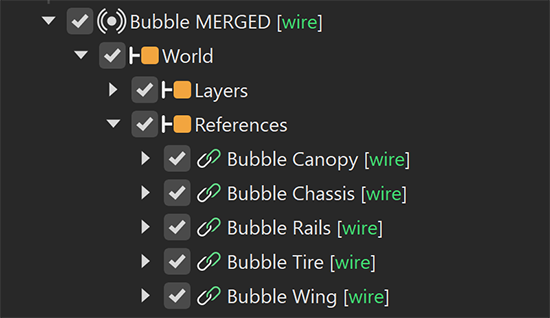How Live References Work in Alias
![]()
Live References can include:
Scene hierarchy - The layer and node structure of your Alias scene is preserved in VRED and displays in the Scenegraph. Note that VRED does not make the distinction between layer folders and layers.They both display as groups in the Scenegraph.
NURBS surfaces, NURBS curves, and subdivision - These objects appear in VRED as tessellated meshes. For the Live Reference, Alias tessellates the geometry using the current Global Tessellation settings. To use Alias tessellation settings, ensure that Tessellation is turned on in the Live Reference options. Otherwise, the surface data is tessellated by VRED when it connects to the Live Reference.
If you want higher quality tessellation in VRED, you can re-tessellate the surfaces in VRED from the Geometry Editor. In the editor, select the Geometry tab and go to the Tessellation Settings.
Materials and textures - Any materials or textures assigned to the geometry display in VRED. This includes Truelight Materials and MaterialX, as well as multipass, layered, and switch materials.
Lights (with the exceptions of Linear or Ambient lights)
Animation - Keyframe animations are included, with the exception of animated CVs. Motion path animation is not supported in Live References. If your model includes animated surfaces with textures, turn on Freeze Transformations in the Render Settings. For more information, see Working with Decals and Projecting Textures.
Cameras - All cameras and camera positions are included. In VRED, the Camera Editor lists all of the Alias cameras. Select an Alias camera in the editor to see any camera updates.
Annotations - Note that if you update the Visibility of an annotation after you start Live Referencing, the Visible Objects filter may not apply to the hidden annotations.
References - You can include Alias references using the workflow described in Including Alias References.
Environments - The environments from Alias are included in the Live Reference and are visible in VRED. You do not need to set up the environment in VRED separately.
Variants - Alias Variants are included in the Live Reference and are visible in VRED.
You can make changes to the Live Reference in VRED to override the data that is shared from Alias. These changes are local to VRED and will not apply to the original .wire file. View edited or transformed nodes, as well as changes to materials, node names, visibility, and structure by using the Live Reference Node Filters in VRED. You can also right-click nodes to revert changes made to specific elements in VRED (See Revert Context Menu for more information).
Live Reference settings in Alias
You can access the following options by selecting the ![]() icon from the promptline action bar.
icon from the promptline action bar.
Enable Live - Creates a Live Reference containing the data currently loaded in Alias. If the data has not been saved to a .wire file, this option will not be available. In this case, save the file or select Enable on Save.
As Alias creates the Live Reference, the icon turns orange (
 ) to indicate that updates are pending, then to green (
) to indicate that updates are pending, then to green ( ) to indicate that the Live Reference is now available to be shared with VRED. If the connection to the Live Reference is broken, which can occur if Live Referenced data is deleted, the icon turns red (
) to indicate that the Live Reference is now available to be shared with VRED. If the connection to the Live Reference is broken, which can occur if Live Referenced data is deleted, the icon turns red ( ).
). Enable on Save - Creates or updates Live Reference data when you save the .wire file. The (
 ) icon displays to indicate that there are updates pending when the file is saved.
) icon displays to indicate that there are updates pending when the file is saved. Use this option for the best performance when working with large files. It also allows Alias users to control when updates are sent to VRED.
Sync - Updates Live Reference data without saving the updates to the .wire file.
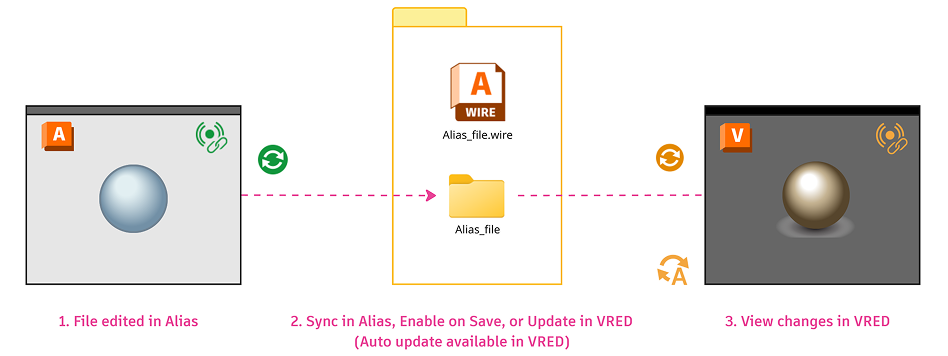
Disable - Turns off Live Referencing and breaks the connection to the Live Reference data.
Live Referencing information window - After enabling Live Referencing, hovering your mouse over the Live Reference icon displays information about the Live Reference.

Filters
Use the filters to specify the Alias data you want to include in your Live Reference to use in VRED for visualization. This lets you choose only the data you want for visualization using layer or visibility states, for example.
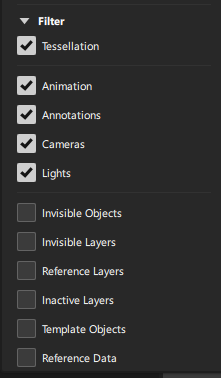
Managing Live Reference Files
When you enable Live Referencing for an Alias .wire file, Live Reference data gets created, which can then be shared with VRED. By default, Live Reference data is saved in a directory named after the source .wire file and in the same location. There are other ways to specify the location of the data files:
- Use
ALIAS_VRED_LIVEREF_LOCenvironment variable. - Use the Live Reference Data preference in the File Paths section of the General Preferences.
When you create the connection to the Live Reference in VRED, the application searches these locations for the Live Reference and in this order:
- Environment variable - If the
ALIAS_VRED_LIVEREF_LOCenvironment variable is used to set the file path, and the Live Reference data is available, VRED stops looking for other paths and loads the data. - General Preferences Location - Alias and VRED each have a Live Reference search path preference, which can be used to set the file path to the shared data. If the preference is set to the same path in Alias and VRED, both applications write and read from this location. If a path is only set in the Alias preferences, VRED uses the next path, which is the .wire file header.
- .wire file header - When you create a Live Reference in Alias, then save the loaded .wire file, the location of the associated Live Reference data is saved directly in the .wire file header. If a custom path is set in Alias, such as to a shared drive location, but no path is set in VRED, VRED can still locate the associated Live Reference data using the .wire file header.
- Default location - If VRED is unable to locate the Live Reference using any of the above locations, it goes the directory of the source .wire file and attempts to load the data from there.
Create a Live Reference
Live Referencing starts in Alias with your currently loaded .wire file. When you turn on Enable Live or Enable Live on Save, a Live Reference version of the data is created, which can then be shared with VRED. In VRED, you create the connection to the Live Reference. Your data now appears the same in both applications without additional modifications.
Preparing an Alias .wire files for Live Referencing
To ensure that your Alias data appears as expected in VRED, follow these guidelines when preparing your Alias .wire file for Live Referencing:
- Lights - Replace any Linear or Ambient lights with light types supported by VRED. These include Spot, Directional, Area, and Point lights.
- Normals - Ensure that surface normals are correctly aligned so they don't need to be adjusted in VRED.
- Assign VRED-based materials, such as those in the VRED Assets Shader Library. Any assigned Alias-based shaders are replaced with the VRED default plastic material.
- Before sending data to VRED, Alias tessellates surfaces using the current Global Tessellation settings. If you want higher quality tessellation, you can re-tessellate the surfaces in VRED from the Geometry Editor. In the editor, select the Geometry tab and go to the Tessellation Settings.
- Ensure that any geometry or objects in the viewport that you don't want sent to VRED are set to invisible or are assigned to a hidden layer.
- If your Alias data includes models with textures mapped to the assigned materials, consider turning on Freeze Texture Transforms in the Render Settings window. This way, the textures will display as expected if the model is animated or rescaled. For more information, see Working with Decals and Projecting Textures.
Create the Live Reference in Alias
In Alias, open the .wire file that contains the data you want to share with VRED.
Select the
 icon from the promptline action bar.
icon from the promptline action bar. From the menu that appears, choose the data you want to include in the Live Reference from Filter list:
 Note: Turn on Tessellation to use Alias tessellation settings. Otherwise, the surface data is tessellated by VRED when it connects to the Live Reference.
Note: Turn on Tessellation to use Alias tessellation settings. Otherwise, the surface data is tessellated by VRED when it connects to the Live Reference.Select either of the following:
- Enable Live to create the Live Reference version of the .wire file data.
- Enable on Save to create the Live Reference version of the .wire file data only when you save the .wire file. Use this option for the best performance when working with large files.
As Alias prepares the Live Reference, the icon turns orange (
 ) to indicate that updates are pending, then to green (
) to indicate that updates are pending, then to green ( ) to indicate that the Live Reference has been created and can now be shared with VRED. If the connection to the Live Reference is broken, which can occur if referenced data is deleted, the icon turns red (
) to indicate that the Live Reference has been created and can now be shared with VRED. If the connection to the Live Reference is broken, which can occur if referenced data is deleted, the icon turns red ( ).
). 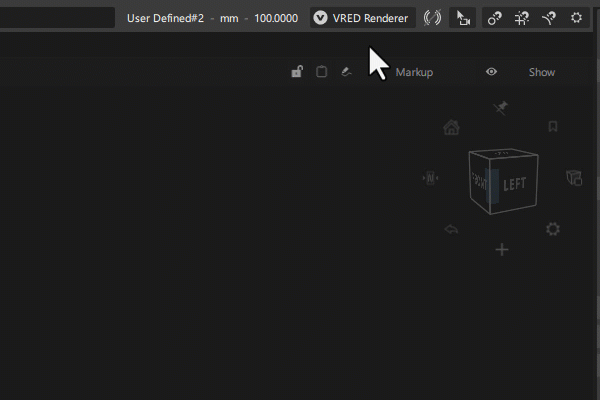
Create a connection to the Live Reference data in VRED
In VRED, you need to create a connection to the Live Reference data created by Alias.
In VRED, open the Live Reference module by selecting Scene > Live Reference.
In the Live Reference module, select the Create Live Reference icon:
 .
.Browse to the location of the Alias .wire file used to create the Live Reference and select it.
When the Create Live Reference window opens, choose whether to apply materials from the Asset Manager before the Live Reference is created. This can save you time.
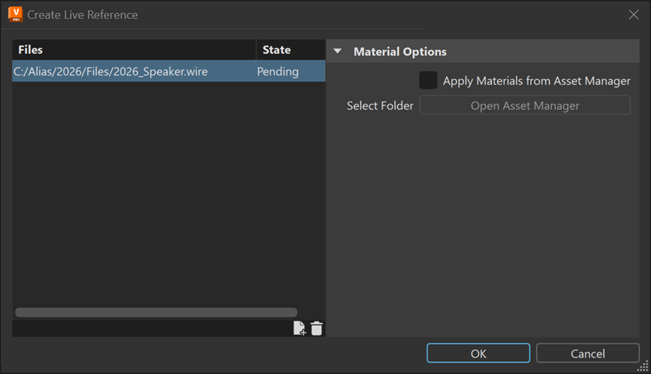
Click OK.
If no issues arise, a live connection is established between Alias and VRED, and the file is added to the Live References list.
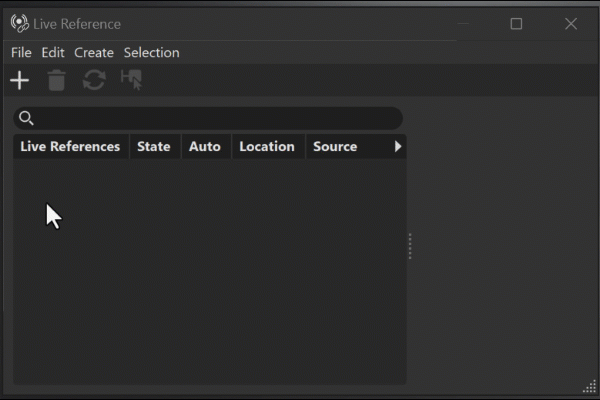
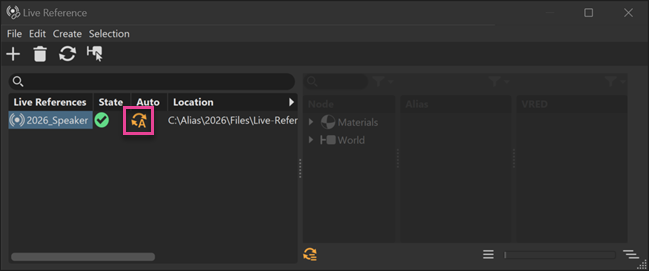
For more information about Live References in VRED, see How Live References Work In VRED.
Include Alias References in a Live Reference
You can include Alias references in your Live Referencing data, including Alias references created from Alias supported file formats, such as .catpart, .prt, and .jt.
Adding Alias references to a Live References works in these scenarios.
- If the .wire source files for an Alias reference have already been previously included in a Live Reference, VRED can locate the Live Reference version of the data. The Alias references load automatically.
- If the .wire source files have not been included in previous Live Reference, you need to load the Alias references as VRED references in VRED. You can do this after creating the connection to the Live Reference. For more information about this workflow, see To include Alias references below.
To include Alias references
Creating a Live Reference that includes Alias references is the same as creating a Live Reference, but with some additional steps.
In Alias, ensure that the Alias references are up-to-date in the file you want to Live Reference.
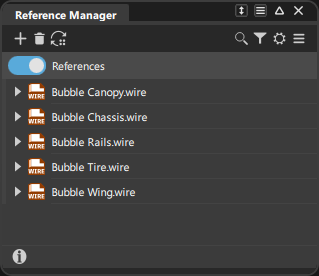
Turn on the Reference Data filter before you create the Live Reference.

In VRED, after creating the connection to the Live Reference, you need import the Alias references files as VRED references. To do this, locate the Live Reference file in the Scenegraph.
In the Graph, expand the hierarchy of the Live Referenced file to locate the Reference folder. This folder contains the Alias reference data.
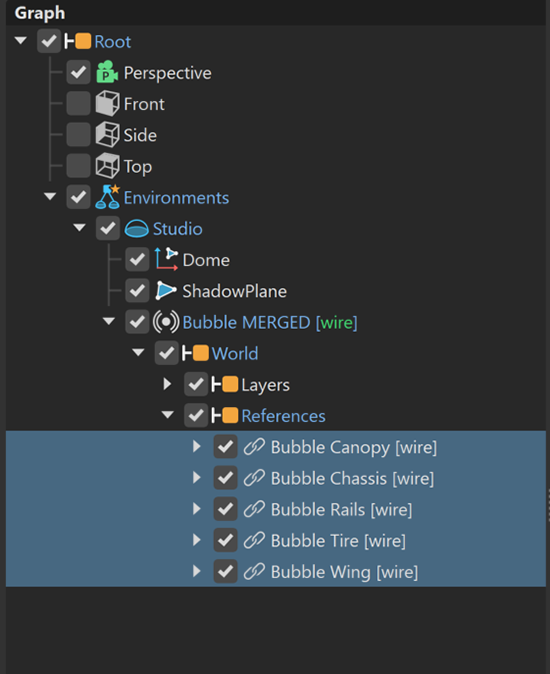
Select the references, right-click, then select Reference > Load.
The Alias references now appear in VRED.
